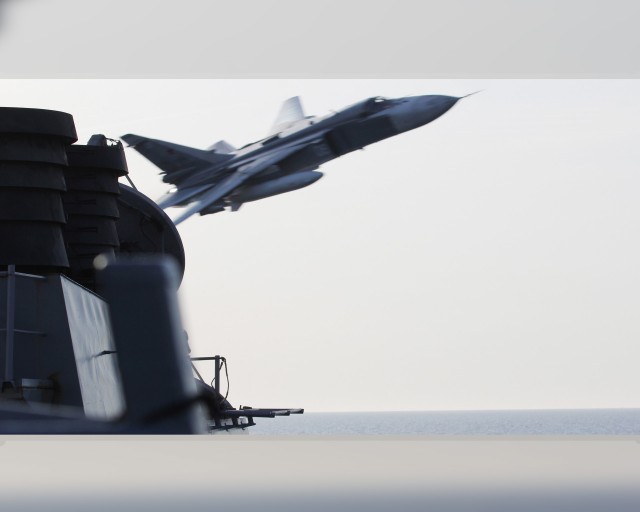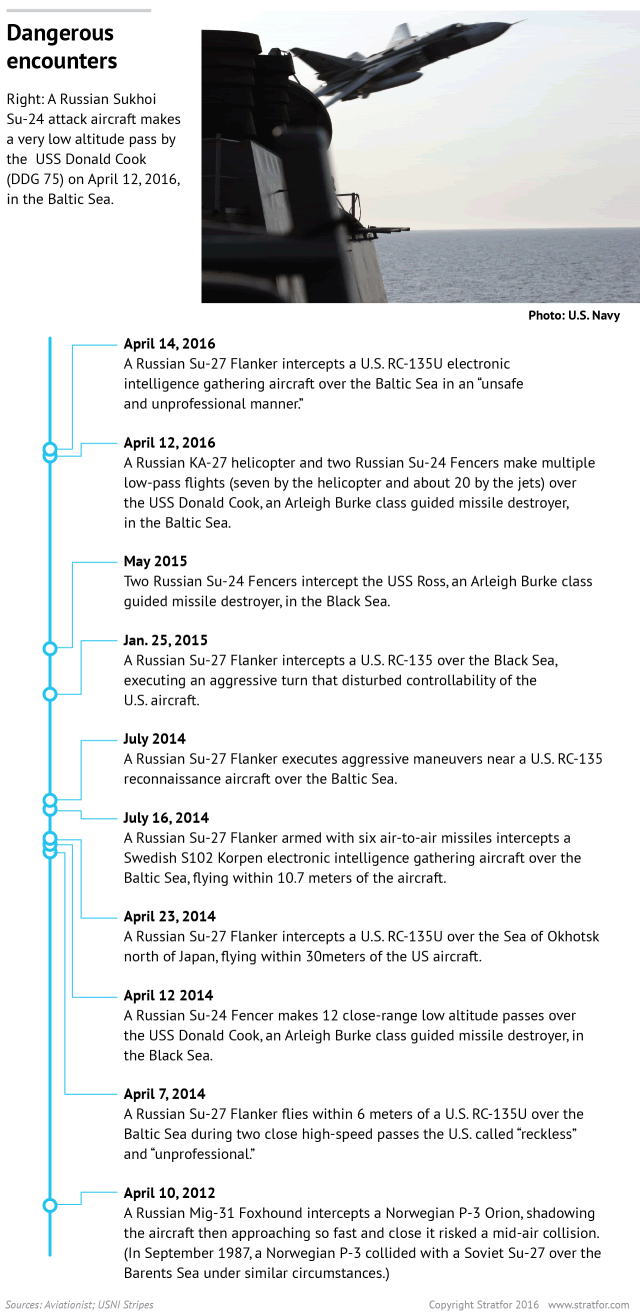Why Russia Harasses U.S. Aircraft and Ships
Politics / New Cold War Apr 24, 2016 - 05:28 PM GMTBy: STRATFOR
 Since Russia annexed Crimea in 2014, tension with the West has been high, affecting eastern Ukraine, Syria and hot spots across the former Soviet sphere. Less overtly, Moscow has been working to protect areas vital to Russian interests by raising the stakes of U.S. operations there. This has manifested in numerous aggressive interceptions of U.S. military aircraft in flight, especially over the Black and Baltic seas. The interceptions, which are reportedly occurring more frequently, aim to dissuade Washington from operating in that airspace.
Since Russia annexed Crimea in 2014, tension with the West has been high, affecting eastern Ukraine, Syria and hot spots across the former Soviet sphere. Less overtly, Moscow has been working to protect areas vital to Russian interests by raising the stakes of U.S. operations there. This has manifested in numerous aggressive interceptions of U.S. military aircraft in flight, especially over the Black and Baltic seas. The interceptions, which are reportedly occurring more frequently, aim to dissuade Washington from operating in that airspace.

A Russian Su-24 jet makes a close-range and low-altitude pass near the USS Donald Cook in the Baltic Sea on April 12. Russia sometimes uses close interceptions to deter U.S. craft without sparking outright combat. (U.S. Navy)
Analysis
On April 14, a Russian Su-27 fighter jet performed a barrel roll maneuver over a U.S. Air Force RC-135 spy plane flying in international airspace over the Baltic Sea. Just three days earlier, two Russian Su-24 bombers flew dangerously and repeatedly close to a U.S. destroyer, also in the Baltic Sea. The most recent intercept came less than a week before the NATO-Russia Council is set to convene for the first time since 2014. Along with the fighting in Ukraine and Afghanistan, military transparency and risk reduction — timely and relevant topics given the interception incidents — will be up for discussion at the meeting.
Not all interceptions are aggressive. In fact, the tactic is standard practice among militaries, both in the air and at sea. Around the world, aircraft and ships from a multitude of countries routinely intercept, visually inspect and escort other aircraft and maritime vessels passing through sensitive airspace or waters. Air forces, navies and coast guards worldwide regularly perform intercepts of this kind to enforce an air defense identification zone such as that in the East China Sea, to police operations such as NATO's Baltic Air Policing mission or, as necessary, to conduct ad hoc tactics. In these capacities, interceptions are almost invariably non-threatening; they are simply a means by which nations enhance their situational awareness and protect against contingencies.
But some interceptions deviate from the norm. In a deliberate ploy to deter a nation's forces from transiting a specific space, aircraft or ships may display aggressive maneuvers, harassing and intimidating targets. These interceptions resemble a high-stakes game of chicken, daring the foreign craft to continue on its route, despite the increased risk of collision, or back down.

Though the tactic carries a risk of damage to both sides, the initiator holds the advantage. Usually in aerial interceptions, a sleek, fast fighter jet targets a lumbering bomber or reconnaissance plane. The initiator of the encounter is often far less valuable — in monetary cost and in the number of flight crew aboard — than the intercepted target, raising the stakes for leaders (and crew) as they decide how to respond. As a fighter jet carries out dangerous maneuvers around it, the target is left to wonder about the interceptor's intentions and skill.
For Russia, close interceptions offer a means to deter U.S. craft without sparking outright combat. The tactic has worked for Moscow already: In July 2014, a Russian jet's aggressive flight so alarmed the crew of a U.S. RC-135 over the Baltic Sea that it accidentally fled into Swedish airspace to evade the interceptor.
But close intercepts do not always go as planned. In the April 2001 Hainan Island incident, for example, a collision during a close intercept left a Chinese pilot dead, his J-8II interceptor destroyed and a U.S. EP-3E signals intelligence aircraft seriously damaged. A number of Cold War-era close intercepts also caused collisions, particularly between ships. This led to the 1972 U.S.-Soviet Incidents at Sea Agreement, which sought to reduce the chances of collision and manage escalation when collisions did occur. Further efforts to limit the risk of escalation produced the 2014 Code for Unplanned Encounters at Sea, which included Russia and China, as well as a 2014 agreement between the United States and China to regulate incidents between the two.
But the past few years have demonstrated that the agreements are not enough to stop such dangerous close encounters, at least not between the United States and Russia. And given the substantial tension between the two countries, a midair or at-sea collision resulting from a close interception could trigger retaliatory measures, leading to an escalation that neither side wants. Even so, as long as tension persists between Russia and the United States, the interceptions are likely to continue.
"Why Russia Harasses U.S. Aircraft is republished with permission of Stratfor."
This analysis was just a fraction of what our Members enjoy, Click Here to start your Free Membership Trial Today! "This report is republished with permission of STRATFOR"
© Copyright 2016 Stratfor. All rights reserved
Disclaimer: The above is a matter of opinion provided for general information purposes only. Information and analysis above are derived from sources and utilising methods believed to be reliable, but we cannot accept responsibility for any losses you may incur as a result of this analysis.
STRATFOR Archive |
© 2005-2022 http://www.MarketOracle.co.uk - The Market Oracle is a FREE Daily Financial Markets Analysis & Forecasting online publication.



